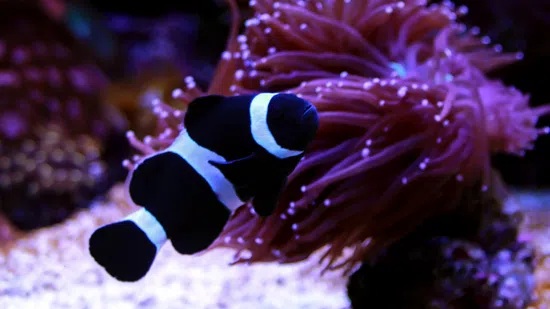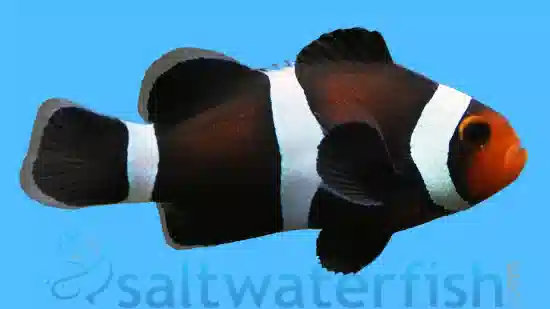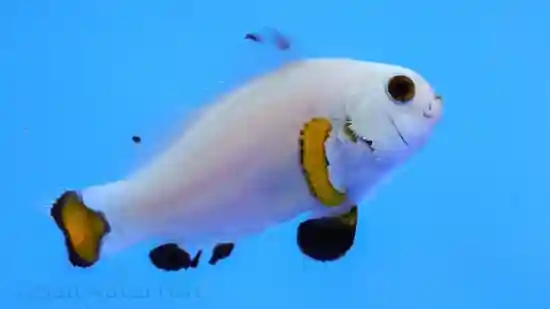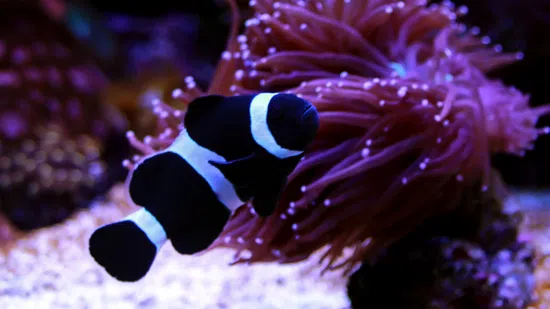Darwin Clownfish - Captive Bred
Amphiprion ocellaris
(40 Reviews)



Darwin Clownfish - Captive Bred
Amphiprion ocellaris
(40 Reviews)
{{ item.name }}
Size: {{ item.extra_field_3 }}
${{ getFormattedPrice(item.saleprice) }} ${{ getFormattedPrice(item.price) }}
To join the waiting list, click here
Free Shipping
With
$199.00
or more in Marine Life.
More details...
Darwin Clownfish - Captive Bred Care Facts
| Care Level: | Easy |
|---|---|
| Temperament: | Peaceful |
| Diet: | Omnivore |
| Origin: | Pacific Ocean |
| Acclimation Time: | 2+ hours |
| Reef Safe: | Yes |
| Minimum Tank Size: | 20 gallons |
| Max Size: | 3 inches |
The Darwin Clownfish (Amphiprion ocellaris) has a pitch-black body with solid white stripes; Juveniles will have orange faces and underbellies, but develop darker colors as they mature. Wild populations only exist off Darwin, in North Australia, where they thrive among the reefs. They are omnivorous by nature, requiring a mixture of meaty preparations, as well as plant fiber and seaweed. These fish will accept most fish foods and are perfect for reef tanks. More than one can be kept in the same aquarium and they prefer to be kept in groups.
Clownfish have a very distinct swimming motion that is different from most fish. This is likely passed on through their genetic makeup from centuries of wiggling within the tentacles of Anemones. As the Clownfish wiggles within the stinging tentacles the Anemone's mucus is likely smeared over the Clownfish's body, which then protects it from additional stings. In the wild they live in small groups with one large dominant female, one smaller sexually active male, and a handful of smaller males and juveniles. When the female is lost the largest male will then change sex and become the dominant female with the other Clowns moving up the ladder behind it.
The Darwin Clownfish (Amphiprion ocellaris): A Charismatic Gem for Saltwater Aquariums
The Darwin Clownfish (Amphiprion ocellaris) is a captivating and charismatic species that adds color and personality to saltwater aquariums. Known for its striking appearance and engaging behavior, this clownfish has become a sought-after choice among marine enthusiasts. Let's explore the Darwin Clownfish's habitat, reef-safe nature, size, lifespan, diet, aquaculture options, compatibility, suitable tank mates, symbiotic relationships, tank requirements, other common names, and compatible tank mates.
Darwin Clownfish Habitat
The Darwin Clownfish is native to the warm waters of the Indo-Pacific region, ranging from the eastern Indian Ocean to the western Pacific Ocean. In the wild, they inhabit shallow lagoons and reef areas, often seeking shelter among the tentacles of sea anemones.
Reef-Safe Nature of the Darwin Clownfish
The Darwin Clownfish is reef-safe and poses no threat to corals or other invertebrates. They form a unique and beneficial symbiotic relationship with certain species of sea anemones.
Darwin Clownfish Size and Lifespan
Darwin Clownfish can grow to be about 3 to 4 inches (7.5 to 10 cm) in length. With proper care, they can have a lifespan of up to 10 years in a well-maintained aquarium.
Diet and Feeding Habits of the Darwin Clownfish
Darwin Clownfish are omnivores in their natural habitat, feeding on various small organisms, including plankton, algae, and small crustaceans. In a home aquarium, they readily accept a diet of high-quality frozen or live foods like brine shrimp, mysis shrimp, and marine pellets.
Aquaculture Options for the Darwin Clownfish
The Darwin Clownfish is widely available in the aquarium trade, and captive-bred specimens are readily accessible. Breeding and propagating this species in captivity have been successful, making it a sustainable choice for marine aquariums.
Compatibility and Suitable Tank Mates for the Darwin Clownfish
- Firefish (Nemateleotris magnifica): These small and peaceful fish share a compatible tank environment with the Darwin Clownfish.
- Gobies (e.g., watchman gobies or neon gobies): Peaceful gobies can coexist harmoniously with the clownfish, adding diversity to the tank.
- Pseudochromis (e.g., dottybacks): Certain species of pseudochromis can coexist with the clownfish, adding color and personality to the tank.
- Blennies: Some species of blennies are suitable tank mates that add character and charm to the aquarium.
- Cardinalfish: Peaceful and colorful, cardinalfish make compatible tank mates for the Darwin Clownfish.
Symbiotic Relationships of the Darwin Clownfish
Darwin Clownfish form a mutualistic symbiotic relationship with certain species of sea anemones. They live among the anemone's tentacles, gaining protection from predators while providing the anemone with food and nutrients.
Tank Requirements for the Darwin Clownfish
To provide a suitable environment for the Darwin Clownfish, the aquarium should mimic their natural habitat with plenty of live rock, hiding spots, and open areas for swimming. A suitable sea anemone is optional, as captive-bred clownfish can thrive without one.
Other Common Names for the Darwin Clownfish
Besides the name "Darwin Clownfish," this species is also known more generically as the "Ocellaris Clownfish" or "False Percula Clownfish."
In conclusion, the Darwin Clownfish (Amphiprion ocellaris) is a charismatic and delightful addition to saltwater aquariums. Its vibrant colors and engaging behavior make it popular among marine enthusiasts. Aquarists can enjoy the beauty and charm of these captivating clownfish by providing them with a suitable environment, compatible tank mates, and proper care.
Very nice fish. for my daughter and she loves him
Reviewed by: Debbie Cook on Feb. 23, 2025
Healthy and beautiful.
Reviewed by: Martin Tran on Feb. 4, 2025
Reviewed by: Faith Singh on Jan. 15, 2025
Doing well.
Reviewed by: Ted Telford on Dec. 25, 2024
Great clowns
Reviewed by: Debbie Cook on Dec. 16, 2024
Beautiful color. The two of them quickly bonded with the other clowns in the tank. Acclimated well and we’re eating immediately. A great addition to a community tank!
Reviewed by: Frank Godlewski on Dec. 10, 2024
Great!
Reviewed by: Rick Scheetz on Nov. 25, 2024
Fish is healthy and doing great
Reviewed by: Brandon Phoenix on Oct. 31, 2024
Reviewed by: Juan Vargas on Oct. 29, 2024
Reviewed by: Brian Coody on Oct. 14, 2024
Absolutely love it, perfect size
Reviewed by: Scott Olson on Oct. 9, 2024
Reviewed by: Dawnnetta Garcia on Sept. 29, 2024
Reviewed by: Gary Sparks on Sept. 16, 2024
The juvenile I received is so cute, exactly as the description says. Black and white with a bit of orange in the face. I am excited to see what he looks like as an adult.
Reviewed by: William Brooks on Sept. 6, 2024
Reviewed by: Allen Wold on Sept. 4, 2024
Great little fish
Reviewed by: David Miller on Aug. 7, 2024
Reviewed by: Jeffrey Bagley on Aug. 5, 2024
Reviewed by: Lazar Jones on July 16, 2024
Arrived alive and happy
Reviewed by: Josh Pritchett on June 17, 2024
Reviewed by: Francene Livingston on June 10, 2024
He is doing good
Reviewed by: Margaret Fansler on June 3, 2024
Reviewed by: Craig Hutton on May 19, 2024
Reviewed by: Billy Springer on May 13, 2024
Reviewed by: Jason Steele on May 9, 2024
Reviewed by: Mike Malkiewicz on April 24, 2024
The Darwin clown fish are healthy & beautiful will always shop from Saltwaterfish.com awesome staff
Reviewed by: Jaime Villegas on April 21, 2024
Reviewed by: Jeffrey Huth on April 10, 2024
They are doing good eating and swimming with our larger clowns.
Reviewed by: Rudy Demaria on March 21, 2024
Reviewed by: Bryan Kaufman on March 17, 2024
Reviewed by: Cameron Kreger on March 17, 2024
Reviewed by: Chris Lambert on March 15, 2024
Reviewed by: Jose Ramirez on March 6, 2024
Healthy and beautiful
Reviewed by: William Chester on Feb. 25, 2024
Reviewed by: Brianne Goodon on Feb. 21, 2024
Spunky little guy took off eating paired up with our other clown already
Reviewed by: Anthony Little on Feb. 1, 2024
Reviewed by: Anthony Scott on Jan. 31, 2024
Nice fish thriving well
Reviewed by: Kim Smith on Dec. 3, 2023
Reviewed by: Mike Connolly on Nov. 27, 2023
One of my favorite saltwater fish.
Reviewed by: Thomas Glanz on June 29, 2023
I was happily surprised at how large & healthy the clownfish were. They acclimated beautifully and quickly became tank favorites.
Reviewed by: Donna on Aug. 13, 2021















